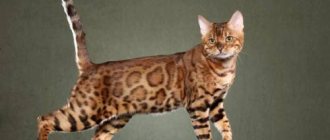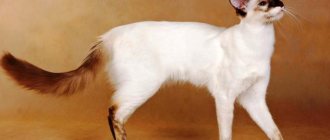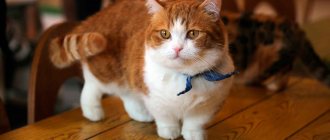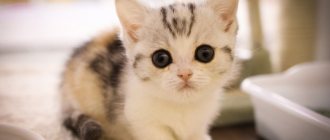| Origin | USA |
| Wool | long flowing |
| Dimensions | medium, weight 2.5–5 kg |
| Lifespan | up to 15 years |
The gracefulness and smooth movements of a domestic animal, comparable to the plasticity of Balinese dancers, determined the name of the Balinese cat breed. With a proud posture, the Balinese is unexpectedly playful and affectionate, requiring increased attention. The intelligent look of beautifully outlined blue eyes emphasizes the aristocracy and intelligence of the pet, whose middle name is Balinese cat.
Mister Cat Tells: An Origin Story
How the Balinese appeared has not yet been established. It is only known that their homeland is the USA. It is believed that these graceful and intelligent animals are a mixture of Siamese and Angora cats. Perhaps one of the breeders deliberately crossed the two breeds.
Another version is a natural mutation. For a long time, when a kitten with long fur appeared in a litter, this was considered a defect. But in 1940, the American Marion Dorset made a separate breed from these rejected lumps. And in 1950, thanks to the breeder, they began to breed a new variety of cats.
After a while, felinologist Helen Smith also took part in the fate of these cats. The famous animal lover came up with a name for them - balinese. The graceful gait of the pets reminded the woman of the graceful movements of the dancers of Fr. Bali.
In the 70s, a new breed of cat gained recognition in America. A decade later, long-haired beauties conquered Europe, and then the whole world.
Breed description and standards
Balinese cats are similar in appearance to Siamese cats. They have the same proportions: long legs and body. They have developed muscles. They differ from their smooth-haired relatives only in their exquisite “fur coat”.
Head and muzzle
The head is medium-sized and wedge-shaped, tapering toward the nose. Their ears are large, pointed, and widely spaced. Straight, slightly elongated nose. Blue or blue oriental eyes are elongated, huge and bright. The forehead is smooth.
Frame
The body is elongated, muscular and toned. They have graceful and thin legs, the hind legs are slightly longer. Small paws are oval shaped. The tail is long, widened, with a fringe at the end. The weight of a purebred cat does not exceed 5 kg.
Coat and colors
The coat is fine and silky, of medium length, without undercoat. Kittens are born white and acquire their new color after about three months. The color is fully formed by one and a half years.
The color has the following names: blue-, seal-, frost-, chocolate-, cream-point. There is also a solid one. But if the name contains the prefix “point”, then the cat has a mask (on the face, legs, tail, ears) in dark colors.
Chocolate point
The body is much lighter or completely white.
The more noticeable the contrast, the more valuable the cat is considered.
The animal's fur is smooth, and only on the tail, neck and chin is wavy.
Photo gallery of Balinese:
Beware: scammers!
Many gullible buyers find offers from scammers who offer such a curiosity as a Balinese cat more tempting to buy for almost five hundred rubles. Any fluffy color-point kitten can be passed off as a Balinese baby. It could be a defective mustache from a Siamese litter, or a completely outbred tailed cub.
Only an experienced specialist can distinguish the “original” from the “fake”, and therefore the main advice to inexperienced breeders: be sure to show the potential pet to a knowledgeable person. Of course, it’s easier to do this if you buy a kitten at an exhibition, where you can seek advice from an expert on the spot.
Also, don’t rely on Matroskin the cat’s introduction: “Whiskers, paws and tail—these are my documents!” A Balinese kitten must have real documents.
In addition, the buyer has the right to look at the pedigree of the mustachioed mom and dad, find out the exact contacts of the club in which the parents' breeders are registered, and even make an appointment there for a personal acquaintance.
Character
These are playful, energetic, temperamental animals. They love to run and jump: they will not be entirely comfortable in small apartments. They are intelligent and quite brave.
The Balinese cat is strongly attached to its owner, extremely loyal, and sociable. She can become a good friend. He loves to sit on his lap and sleep next to him, cannot stand loneliness, loves attention and persistently demands it. Loves children and gets along well with other animals. She is inquisitive and needs to be on time everywhere.
The cat is talkative and unusually musical. He can sit on the windowsill for hours and comment on events happening on the street. The voice is pleasant. But she is not as soft and flexible as she looks. He will not allow himself to be squeezed and carried in his arms against his will. May scratch or bite. He perceives shouting and swearing painfully and is immediately offended.
These cats are smart and smart. Instantly navigate the situation. They know what they are allowed to do.
They can walk on a leash and are very trainable, which, as a rule, is not typical for many of their relatives.
Content
It is possible to keep a Balinese in an apartment if there is enough space for playing and jumping. Animals need toys, otherwise they may get bored and start playing with other objects, clothes or shoes.
If you can’t play with your pet yourself, then one option is to buy a second cat (you can have a different breed).
Caring for a Balinese cat is not difficult. She licks herself. It is enough for owners to comb its fur with a special brush every other day. The Balinese is not afraid to wash itself and reacts calmly to water. You can always buy special shampoos for him in the store. After bathing, the animal must be carefully dried with a heated soft towel and taken to a place where it will not be blown through.
One of the problems this breed has is the accumulation of mucus in the corners of the eyes. It must be removed using cotton pads. Regular oral examination is necessary. It is advisable to brush your teeth weekly with a special paste.
Nutrition
The Balinese cat is not capricious when it comes to food, but a balanced diet is the key to the health of your furry pet. The menu should be varied and healthy.
The following products are used for preparation:
- different types of raw lean meat (necessarily well frozen);
- fresh heart;
- liver;
- egg yolks;
- kelp;
- fish fat;
- plantain seeds;
- vitamins B and E;
- water.
Cooked food is placed in containers and put into the freezer. When defrosting, do not use a microwave oven. The food is heated in a cup of warm water. For constipation, you can add pureed vegetables to your diet.
It is important that your cat always has fresh water.
Diet
Premium ready-made food is ideal for the “dancing cat,” which contains all the necessary vitamins and minerals. Characteristics of the optimal diet for Balinese people of different ages are presented in the following table.
Table 2. Diet of Balinese cats
| Age | Number of feedings per day |
| Up to 6 months | 4 |
| 6-12 months | 3 |
| Over 12 months | 2 |
Organic food is not the best food option for Balinese people. But if it is more convenient for you to feed your pet this particular food, give preference to different types of meat, vegetables and cereals. And be sure to include vitamins in your diet.
Premium food will provide the Balinese’s body with all the necessary vitamins
Meat (lean beef, veal) should make up 60% of the cat's diet. Poultry contains much less amino acids than meat, so it is given to the cat no more than twice a week. Meat and poultry are offered to the pet boiled, without veins, after cutting it into pieces that are convenient for chewing.
Once a week the cat is given a fish day. On this day, she is served boiled sea fish as the main dish. Parasites are more common in river fish, so you should not include it in your pet’s diet.
River fish is dangerous to your pet's health due to the parasites that are often found in it.
The remaining 40% of the diet should consist of whole grain cereals (30%) and stewed vegetables (10%).
Table 3. Diet of the Balinese cat
| Products | Specific gravity, % |
| Meat, fish, poultry | 60 |
| Boiled cereals | 30 |
| Vegetable stew | 10 |
To make your cat happy with a shiny coat and a lively sparkle in her eyes, you need to carefully calculate the energy value of her diet, include all the recommended products in it and monitor the volume of portions. Porridge can be served with kefir or yogurt. The menu can be supplemented with low-fat cottage cheese and sour cream diluted with warm water. It is better to avoid milk, as it can cause indigestion in an adult cat.
Contrary to popular belief, milk is not intended for adult cats.
Health and allergies
Balinese cats, like other felines, can get sick. They have the following pathologies:
- Liver disease: when protein metabolism is disrupted, amyloid is deposited in the tissues. Liver dysfunction develops. The disease can be fatal.
- Diabetes mellitus: failure of the pancreas. The most common symptom is obesity.
- Asthma: With proper treatment, your pet can lead an active life and live a long time.
- Siamese strabismus: It is becoming increasingly rare due to careful selection.
Even though Balinese are a healthy breed, they need to be seen by a veterinarian periodically. With good care, they live about 15 years. Also read the article about the life expectancy of cats.
Many people suffer from allergies, including to cats. But it happens less often with Balinese than with other breeds. These cats produce fewer allergens than their relatives. Balinese dogs are considered hypoallergenic.
Diseases
This breed is in good health - alas! – can’t boast. The most common ailments:
- Strabismus (this problem can be obvious or smoothed out, but one thing is known: you cannot get rid of it);
- Cutaneous asthenia is a pathology in which the skin becomes so thin that it is injured even with normal movement;
- Asthma - it is caused by some allergen;
- Esophageal achalasia – the esophagus increases in size, causing the cat to belch, vomit, and have abdominal pain;
- A defect of the heart muscle is detected in kittens. There is no treatment;
- Amyloidosis of the liver and kidneys is a common disorder. The disease cannot be cured, but supportive therapy and diet can significantly prolong the life of a pet.
In addition, Balinese cats are more prone to cancer than others: lung cancer, mammary cancer. Elderly people often suffer from diabetes.
Puberty in males occurs at 9-10 months, in females sometimes earlier. However, you should not “breed” animals under one and a half years old. Give them time to gain strength. Keep in mind: during the rutting period, the cat becomes not herself: she can roll on the floor, scream, tear up walls and throw herself at doors.
If you do not plan to breed, consult a veterinarian and he will tell you what operation should be performed in your case. But various kinds of drugs - both drops and tablets - do not work well.
Positive and negative points
Every year Balinese cats become more and more popular. Cute, playful and loyal, they are a favorite for single people and families with children.
Positive aspects of this cat:
- grace and grace;
- calm character;
- love for people;
- lack of aggressive attitude towards children;
- ability to educate and train;
- intelligence and intelligence;
- cleanliness;
- unpretentiousness.
Before buying a cat of this breed, you need to consider the following:
- The Balinese cat cannot stand being alone. She should not be left alone for a long time. Therefore, it is better not to get such a cat for people who are often away from home for a long time.
- Balinese does not tolerate aggression and quarrels. In such cases, it often changes its character and becomes similar to its owner.
- Pets meow often and loudly.
Care
The unusual Balinese cat requires the most ordinary care. Regular care of the fur, eyes, claws and ears is a standard set of measures to maintain the presentable appearance and health of your four-legged pet.
Bathing
The Balinese take excellent care of their coat, so frequent bathing is not necessary. Cats of this breed do not like water; while washing, they may grumble and try to escape from the bathroom. In order for the bathing to go without incident, it is better to call someone from the household for help: while the assistant holds the animal, you wash it with a special shampoo for long-haired cats. The wool should be lathered once. To make combing easier, it is better to treat it with conditioner.
Holding a Balinese while swimming is not an easy task
Dry wet wool with a warm, dry towel. A hairdryer is not used for this, since a strong flow of warm air can dry out the delicate skin and silky hair of the animal.
Wool
The formation of a fur coat in a Balinese cat lasts up to 12-18 months. Based on the condition of its hair, we can conclude how much attention the owner pays to the hygiene of his pet, how often the animal experiences stress and how balanced its diet is.
Balinese wool does not require additional attention, but you should not forget about minimal care
The cat does not have a thick undercoat, which usually rolls into tangles, and this makes it easier to care for its coat. Long guard hairs are combed once a week with a special comb or brush. During periods of molting, this procedure is carried out more often.
Teeth
Balinese cats are at risk for dental diseases, so animals are taught to brush their teeth from young claws. The pet’s oral cavity is examined once a week, and its teeth are cleaned at the same frequency.
Example of liquid toothpaste for cats
To do this, use a special toothpaste and a brush for cats (you can buy it at a pet store). Once a week, your pet should be given special food designed to cleanse teeth. The packaging of this food bears the Dental mark.
Ears
Experts recommend examining your cat's ears once a week. If there is wax in the ear, it is removed with a damp piece of cotton wool or a cotton swab dipped in petroleum jelly.
The external manifestations of ear mites look like this:
If an ear mite is detected, immediately contact a veterinarian. This disease causes significant discomfort to the cat. Because of the itching in her ears, she literally scratches them until they bleed. Therefore, under no circumstances should you let the disease take its course.
Eyes
Regular small discharge from your pet's eyes is considered normal. They can be removed with a damp cotton swab. Deviations from the norm are borderline conditions: the absence of discharge or its profuse flow. In the first case, we can talk about problems with the tear ducts, in the second, about irritation of the mucous membrane or the presence of infection. If there are any deviations from the norm, the cat should be shown to a veterinarian.
Infrequent discharge from the eyes of Balinese dogs is normal and can be eliminated with tampons moistened with warm water.
Claws
Nail trimming is carried out as follows:
- the cat is placed on your lap;
- take the animal’s paw with your left hand and press the pad with your thumb so that a claw appears;
- cut off the tip of the claw;
- Use a regular file to polish the trimmed area.
Tips for trimming cat's claws
The claws contain blood vessels. In order not to touch them while cutting, you must first examine the claw in the light and cut off only the part that is free from blood vessels.
If a blood vessel is touched while trimming the claws, you need to treat the claw with a cotton swab dipped in an antiseptic. If the bleeding does not stop, immediately take the animal to a veterinary clinic.
Choosing a Balinese kitten and cost
When choosing a pet, you should remember that the Balinese beauty is a blue-eyed cat with a long body, large ears and a long nose. It is similar to the Siamese, but its peculiarity is medium-length hair without a hint of undercoat.
At birth, the Balinese is white. To make sure that a kitten is purebred, you need to see its parents with pedigrees.
It is allowed to breed a Balinese cat only with Siamese, Seychelles and long-haired Orientals. The kitten must have a pedigree and a veterinary record with vaccinations.
What does a Balinese kitten look like?
When buying a Balinese, you need to be extremely careful. They are often given away as long-haired kittens of various origins with a “Siamese” color.
A purebred kitten will not be cheap, from 350 USD. by advance reservation. If the animal does not participate in exhibitions and breeding, then you can buy a pet-class cat. This is the same purebred pet without defects, but it is easier to acquire and will cost much less.
How to choose a kitten
In order not to doubt the purebred Balinese kitten, they look at the parents and ask them to show their pedigree and vaccination certificate.
Breeders offer Balinese kittens from the age of 12 weeks, when the animals have been socialized, vaccinated and differ in external characteristics from other subspecies of cats.
A Balinese kitten older than two months is playful and inquisitive. A healthy pet is defined by:
- shiny, silky coat;
- soft belly;
- discharge within normal limits from the nose, eyes, ears;
- pink gums;
- fresh breath;
- good appetite.
Balinese kittens with knots, kinks in the tail, signs of inflammation in the ears, corners of the eyes, and excessive nasal discharge are rejected. Lack of appetite, lethargy, dull fur are symptoms of an unhealthy animal.
According to signs, a Balinese kitten becomes a family favorite if it chooses its owner and is the first one to come to its feet.











